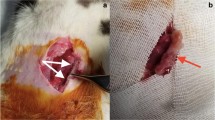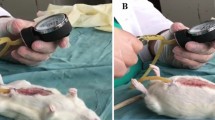Abstract
Each year, approximately 4 million abdominal surgeries are performed, and it is estimated that 10–20 % of these patients develop abdominal hernias at the incision point. Currently, the standard method for repair of such hernias is the use of polypropylene mesh, which has complications such as adhesions. Therefore, it is crucial and logical to search for a type of material which can reduce such complications. This study was conducted in order to determine surgical and histological outcomes of polypropylene mesh coated with human amniotic membrane (HAM) in comparison with polypropylene mesh on its own. Ten rabbits were divided into two equal groups, group I and II. A 5-cm incision was made along the abdomen of each rabbit. In group I, a 2 × 3 cm layer of polypropylene mesh was placed under the wall of the abdomen adjacent to the viscera. In group II, the procedure was identical except that the mesh was covered by a 4 × 6 cm layer of HAM too. After 3 weeks, all animals were sacrificed and tissue samples were provided from the abdominal wall and adjacent viscera to evaluate any adhesion and histological changes in each group. Microscopic evaluation was performed for all samples, and no significant statistical difference was found between groups. It seems that the use of HAM as a coating for polypropylene mesh could have a positive effect in reducing adhesions in the abdominal viscera.
Similar content being viewed by others
References
Abbasi HR, Tahmasebi S, Hosseini SV, Tanideh N, Monabati A, Mehrabani D (2005) Repair of esophageal full–thickness defects with expanded polytetraflouroethylene (PTFE) patch: an experimental study on dogs. J Appl Anim Res 28:89–92
Abbasi HR, Yazdani S, Mehrabani D, Tanideh N, Vasei M, Rasekhi AR, Hosseini SV, Amini M (2008) Evaluation of mushroom catheter for diverting loop ileostomy: an experimental study in dog. J Appl Anim Res 33:25–28
An G, Walter RJ, Nagy K (2004) Closure of abdominal wall defects using acellular dermal matrix. J Trauma 56:1266–1275
Bachman S, Ramshaw B (2008) Prosthetic material in ventral hernia repair: how do I choose? Surg Clin North Am 88:101–112
Barlas M, Gokcora H, Erekul S, Dindar H, Yucesan S (1992) Human amniotic membrane as an intestinal patch for neomucosal growth in the rabbit model. J Pediatr Surg 27:597–601
Bellón JM, Rodríguez M, García-Honduvilla N, Pascual G, Gómez Gil V, Buján J (2007) Peritoneal effects of prosthetic meshes used to repair abdominal wall defects: monitoring adhesions by sequential laparoscopy. J Laparoendosc Adv Surg Tech A 17:160–166
Brunicardi FC, Andersen D, Billiar T, Dunn D, Hunter J, Matthews J, Pollock RE (2014) Schwartz’s principles of surgery, 10th edn. McGraw Hill Professional Publishing, New York, pp 1937–1940
Campanelli G, Nicolosi FM, Pettinari D, Contessini Avesani E (2004) Prosthetic repair, intestinal resection, and potentially contaminated areas: Safe and feasible? Hernia 8:190–192
Castro PM, Rabelato JT, Monteiro GG, del Guerra GC, Mazzurana M, Alvarez GA (2014) Laparoscopy versus laparotomy in the repair of ventral hernias: systematic review and meta-analysis. Arq Gastroenterol 51:205–211
Di Loreto FP, Mangione A, Palmisano E, Cerda JI, Dominguez MJ, Ponce G, Bernaus M, Gaffuri S, Torresi G, Bianco S (2013) Dried human amniotic membrane as an antiadherent layer for intraperitoneal placing of polypropylene mesh in rats. Surg Endosc 27:1435–1440
DuBay DA, Wang X, Adamson B, Kuzon WM Jr, Dennis RG, Franz MG (2006) Mesh incisional herniorrhaphy increases abdominal wall elastic properties: a mechanism for decreased hernia recurrences in comparison with suture repair. Surgery 140:14–24
Ghahramani L, Jahromi AB, Dehghani MR, Ashraf MJ, Rahimikazerooni S, Rezaianzadeh A, Safarpour AR, Hosseini SV (2014) Evaluation of repair in duodenal perforation with human amniotic membrane: an animal model (dog). Int Adv Biomed Res 3:113
Kesting MR, Loeffelbein DJ, Steinstraesser L, Muecke T, Demtroeder C, Sommerer F, Hoelzle F, Wolff KD (2008a) Cryopreserved human amniotic membrane for soft tissue repair in rats. Ann Plast Surg 60:684–691
Kesting MR, Wolff KD, Hohlweg-Majert B, Steinstraesser L (2008b) The role of allogenic amniotic membrane in burn treatment. J Burn Care Res 29:907–916
Kolker AR, Brown DJ, Redstone JS, Scarpinato VM, Wallack MK (2005) Multilayer reconstruction of abdominal wall defects with acellular dermal allograft (AlloDerm) and component separation. Ann Plast Surg 55:36–41
Kruse FE, Meller D (2001) Amniotic membrane transplantation for reconstruction of the ocular surface. Der Ophthalmologe Z Dtsch Ophthalmol Ges 98:801–810
Kuriu Y, Yamagishi H, Otsuji E, Nakashima S, Miyagawa K, Yoshikawa T, Kin S, Nakase Y, Fukuda K, Okamoto K, Sakakura C, Hamuro J, Kurihara E, Hagiwara A (2009) Regeneration of peritoneum using amniotic membrane to prevent postoperative adhesions. Hepatogastroenterology 56:1064–1068
Liang H, Li C, Gao A, Liang P, Shao Y, Lin T, Zhang X (2012) Spinal duraplasty with two novel substitutes restored locomotor function after acute laceration spinal cord injury in rats. J Biomed Mater Res B Appl Biomater 100:2131–2140
Luijendijk RW, Hop WC, van den Tol MP, de Lange DC, Braaksma MM, IJzermans JN, Boelhouwer RU, de Vries BC, Salu MK, Wereldsma JC, Bruijninckx CM, Jeekel J (2000) A comparison of suture repair with mesh repair for incisional hernia. N Engl J Med 343:392–398
Mehrabani D, Sadeghi B, Ashraf MJ, Abbasi HR, Amini M, Tanideh N, Sabet B, Javan H, Vasei M, Hosseini SV (2009) Comparison of simple closure and polytetraflouroethylene (PTFE) patch methods for repair of rectovaginal fistula in dog. J Appl Anim Res 35:73–76
Mucke T, Loeffelbein DJ, Holzle F, Slotta-Huspenina J, Borgmann A, Kanatas AN, Mitchell DA, Wagenpfeil S, Wolff KD, Kesting MR (2010) Intraoral defect coverage with prelaminated epigastric fat flaps with human amniotic membrane in rats. J Biomed Mater Res B Appl Biomater 95:466–474
Najibpour N, Jahantab MB, Hosseinzadeh M, Roshanravan R, Moslemi S, Rahimikazerooni S, Safarpour AR, Ghahramani L, Hosseini SV (2013) The effects of human amniotic membrane on healing of colonic anastomosis in dogs. Ann Color Res 1:97–100
Niknejad H, Peirovi H, Jorjani M, Ahmadiani A, Ghanavi J, Seifalian AM (2008) Properties of the amniotic membrane for potential use in tissue engineering. Eur Cell Mater 15:88–99
Petter-Puchner AH, Fortelny RH, Mika K, Hennerbichler S, Redl H, Gabriel C (2011) Human vital amniotic membrane reduces adhesions in experimental intraperitoneal onlay mesh repair. Surg Endosc 25:2125–2131
Ramirez OM, Ruas E, Dellon AL (1990) "Components separation" method for closure of abdominal-wall defects: an anatomic and clinical study. Plast Reconstr Surg 86:519–526
Ran L, Jin J, Xu Y, Bu Y, Song F (2014) Comparison of robotic surgery with laparoscopy and laparotomy for treatment of endometrial cancer: a meta-analysis. PLoS One 9, e108361
Roshanravan R, Ghahramani L, Hosseinzadeh M, Mohammadipour M, Moslemi S, Rezaianzadeh A et al (2014) A new method to repair recto-vaginal fistula: Use of human amniotic membrane in an animal model. Adv Biomed Res 3:114
Singh R, Chouhan US, Purohit S, Gupta P, Kumar P, Kumar A, Chacharkar MP, Kachhawa D, Ghiya BC (2004) Radiation processed amniotic membranes in the treatment of non-healing ulcers of different etiologies. Cell Tissue Bank 5:129–134
Swan J (2014) Use of cryopreserved, particulate human amniotic membrane and umbilical cord (am/uc) tissue: a case series study for application in the healing of chronic wounds. Surg Technol Int 25:73–78
Uludag M, Citgez B, Ozkaya O, Yetkin G, Ozcan O, Polat N, Isgor A (2009a) Effects of amniotic membrane on the healing of primary colonic anastomoses in the cecal ligation and puncture model of secondary peritonitis in rats. Int J Color Dis 24:559–567
Uludag M, Citgez B, Ozkaya O, Yetkin G, Ozcan O, Polat N et al (2009b) Effects of amniotic membrane on the healing of normal and high-risk colonic anastomoses in rats. Int J Color Dis 24:809–817
Uludag M, Ozdilli K, Citgez B, Yetkin G, Ipcioglu OM, Ozcan O et al (2010) Covering the colon anastomoses with amniotic membrane prevents the negative effects of early intraperitoneal 5-FU administration on anastomotic healing. Int J Color Dis 25:223–232
Yetkin G, Uludag M, Citgez B, Karakoc S, Polat N, Kabukcuoglu F (2009) Prevention of peritoneal adhesions by intraperitoneal administration of vitamin E and human amniotic membrane. Int J Surg 7:561–565
Zelen CM, Gould L, Serena TE, Carter MJ, Keller J, Li WW (2014) A prospective, randomised, controlled, multi-centre comparative effectiveness study of healing using dehydrated human amnion/chorion membrane allograft, bioengineered skin substitute or standard of care for treatment of chronic lower extremity diabetic ulcers. Int Wound J Nov 26. [Epub ahead of print]
Zinner JM, Ashley WS (2012) Maingot’s Abdominal Operations. 12th ed: McGraw-Hill Professional; p. 1328
Acknowledgments
The authors wish to thank the financial support of Shiraz University of Medical Sciences.
Conflict of interest
The authors declare that they no competing interest.
Author information
Authors and Affiliations
Corresponding author
Rights and permissions
About this article
Cite this article
Najibpour, N., Ahmed, M.A.A.H., Bananzadeh, A. et al. The effect of human amniotic membrane as a covering layer on propylene mesh in decrease of adhesion after laparotomy in the rabbit. Comp Clin Pathol 25, 131–135 (2016). https://doi.org/10.1007/s00580-015-2153-5
Received:
Accepted:
Published:
Issue Date:
DOI: https://doi.org/10.1007/s00580-015-2153-5




